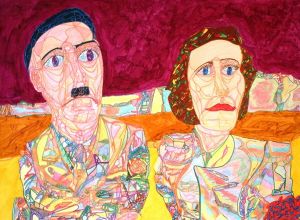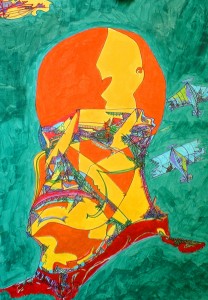On Modern Art: An Interview with Jonathan Bowden

Source#
From Counter-Currents
On Modern Art#
Troy Southgate: You have a keen interest in Modernism. Why does this form of artistic expression appeal to you most and what, in your opinion, makes Modernism so superior to Modern Art?
Jonathan Bowden: Ah yes, the issue of Modernism . . . I’m an ultra-rightwing modernist, let’s make that clear. Even though some of my work is traditional, restorationist, historical and semi-classic in spirit . . . nonetheless, I’m a modernist, even on some occasions an Ultra-modernist. Let’s be definite about this: some of my pictures do relate to Bosch, Redon, Klimt, Bacon, Pacher, ancient Greek sculpture and so on, but primarily I wish to create new and ferocious forms. They must come from within; what you really require is an image the like of which no-one has ever seen before, even dreamt of prior to your conception.
Bacon always declared that he wanted to paint the perfect cry, after the fashion of the nurse on the steps facing the White Guards in Battleship Potemkin. I never wished to paint the greatest scream a la Poussin’s Massacre of the Innocents. No. For my part, I wanted to paint the most ferocious image of my time – these works are not neurotic, paranoid, schizoid, disturbed or mentally ill, as some might suggest . . . they are passionate integers of fury. The effort is to project strength and power.
One cares nothing for the aesthetic standards of the masses; they are children who only like what they know or feel comfortable with. What really matters has to be the ecstasy of becoming – early or classic modernism happened to be exactly that. It was an attack on sentimentality; it proved to be an art purely for intellectuals. It was anti-humanist, elitist, inegalitarian, vanguardist, misanthropic, sexist, racist, and homophobic – all good things. It gave witness to the neo-classic bias within the Modern that related to the theories of T. E. Hulme, a revolutionary conservative, and Ortega y Gasset, a mild fascist.
In the latter’s Dehumanisation of Art he preaches a new style against the Mass – that notion has always intoxicated me; to trample upon the masses and synthesize them into a new evolutionary surge has to be our object. The failure of extremist conservatism, fascism, and National Socialism was material; revolutionary right-wing ideas may only really flourish spiritually: art has to be its vehicle; the stars its limit . . . Homo stultus, the putty.
Early modernism found itself penetrated by these ideas . . . only much later did it become a vehicle for liberal humanism. A move which in and itself related to the academic, restorative and conservative aesthetic tendencies in Soviet and Nazi art. One of the ironies is that revolutionary art becomes liberal wall-paper; while revolutionary movements adopted philistinism as their watchword. Their anti-formalism became a rigid fear of upsetting the majority.
Art partly exists to disturb expectations, but liberal anti-objectivism has gradually dissolved this influence. An image like Tato’s March on Rome becomes more and more diffuse . . . until you end up with a David Hockney sketch, a Yorkshire scene bathed in light, and adorning a corporate office anywhere in the world. But let’s not fall into the trap of talking about the revolution betrayed – that’s such a bore. Also, revolutions are always betrayed; that’s their purpose. It’s only then that we recognise the salient truth: namely, they are part of life’s warp and weft. They have to be taken — to use Truman Capote’s axiom — in Cold Blood. A dilemma which brings us to the exposed issue of post-modernism, I dare say.

TS: A talented and accomplished artist, you have produced over 200 paintings of your own. What first motivated you to take up painting, and how would you describe your own inimitable style?
JB: Unlucky for some, eh? Well, let’s look at it in this way . . . between around six or thirteen years of age I used to draw comics or graphic novels. They were my first form. Around two thousand images definitely came into the world as a consequence of these endeavors. They were my first love, I suppose – primarily due to their combination of words and images. A factor which also accounts for my interest in the graphic, the horrific or Gothic, the linear and the pre-formed. Contrary to the desiderata of pure modernism, in graphic work you always know where you’re going but not necessarily where you intend to end up.
After a brief gap – grammar school and so on – I started to produce images again. Yet now a subtle change had taken place. The pictures underwent a metamorphosis into full-scale paintings and over around thirty years have mounted up to at least 215 works. Some of the early ones are framed; others not. Around 175 or 177 (depending) are available for viewing on my website (www.jonathanbowden.co.uk), sundry sketches and preliminaries will follow . . . and the coup de gras shall be those graphic novels which await scanning and upload at a later date.
Personally speaking, I find them to be captivating in their allure. They are extremely varied in their focus – some are ferocious, savage and expressionist; others are erotic, playful and sensual; still more have a classic, restorationist or historical bias; while the remainder embody autobiographical and ideological themes. Some pertain to child art or the ramifications of Art Brut: that is, a willing or known primitivism in terms of artistic silence. Certain other paintings are literally portraits of people known to me; whilst early on I experimented with the psycho-portrait – here you illuminate a person’s nature and not their looks.
Although eschewing abstraction – unlike Norman Lowell – I’ve never been interested in pure representationality after the invention of photography to do it for you. Do you recall those nineteenth century series of photographs by the master Edward Muybridge? He was one of the great pioneers of slow-motion, frame by frame photography when this art or science was in its infancy. A sequential art motif featuring two men engaged in Graeco-Roman wrestling has to be an early classic. These images in particular had profound influence on Francis Bacon’s oeuvre.
Anyway, if we examine it closely then this tradition splits several ways. It leads to the strip cartoon, the cartoon or funny, comics and the story board – a development that prepares the ground for early silent cinema. So inter alia, the fantastical and linear presentation of action becomes art’s necessity. All of which involves going inside the mind so as to furnish provender – imagination then facilitates change, transmutation, forays from within and the custody of inner space. An eventuality which portends Modernism – why don’t you think of me as a heterosexual version of Francis Bacon? Maybe you could construe yourself, Troy, as the famous critic David Sylvester with whom Bacon had a well-known artistic dialogue in Plato’s tradition. Thames and Hudson published it years ago.
